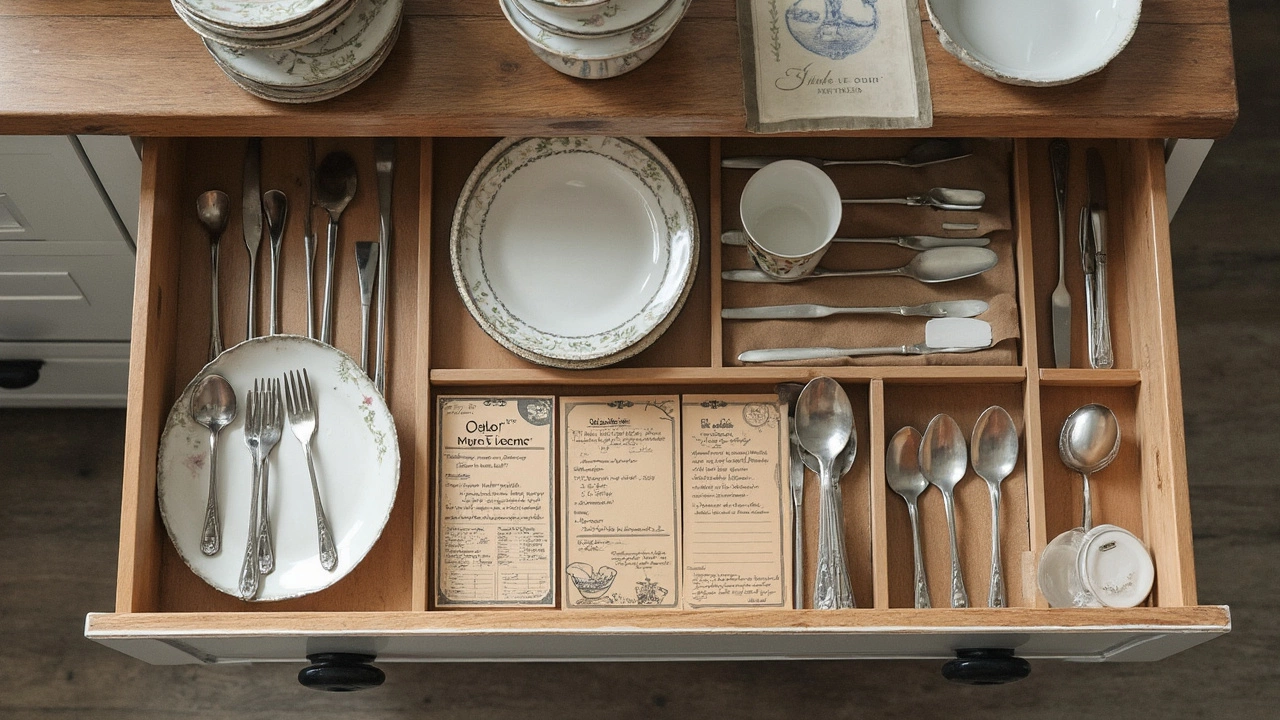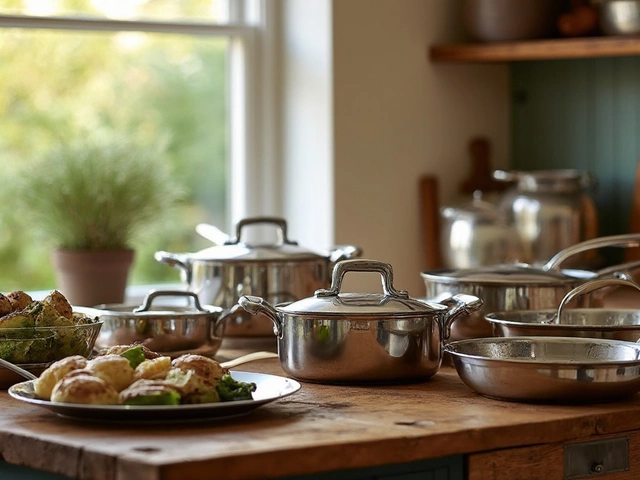If you’ve ever shopped for kitchen stuff or read a restaurant menu, you’ve seen a bunch of names for the same simple things: plates and utensils. People often toss around words like tableware, dinnerware, flatware, or even silverware. It gets confusing, right? Honestly, most of us just call them plates and forks, but knowing a few key terms makes it way easier to find what you need in stores or online.
For example, at a dinner party, someone might ask you to set out the tableware, but in a fancy catalog, they’ll show off their dinnerware set paired with stylish cutlery. It’s all the same basics: stuff you eat with, eat off of, and clean up after. Getting comfy with these names not only helps you sound like you know what’s going on—it can save you time and money when you’re scanning Amazon or setting up a wedding registry.
- Everyday Names for Plates and Utensils
- Tableware vs. Dinnerware vs. Flatware: What’s What?
- Fun Facts & History about Kitchenware Names
- Tips for Choosing and Caring for Your Kitchenware
Everyday Names for Plates and Utensils
When you hear people talk about plates and utensils, they’re usually talking about kitchen basics we use every single day. But these items go by lots of different names, depending on where you are and who you’re talking to. In America, you'll mostly hear folks call them "dishes" for plates and "silverware" for utensils—even when there’s not a drop of silver in sight. Brits, on the other hand, love the word "cutlery" for forks, knives, and spoons. Walk into a store and you’ll spot “tableware” and “flatware” everywhere. It gets a bit wild.
To keep things simple, here’s what tends to pop up in American homes and shops:
- Plates — Also called dishes, dinner plates, or serving plates (depending on the size).
- Bowls — Everyone knows these, but they might show up as soup bowls or cereal bowls in shop labels.
- Utensils — This covers forks, knives, and spoons, but people will call the whole group "silverware" or "flatware." Some folks just say "cutlery" too.
- Cups and Glasses — These get lumped in as drinkware sometimes, but some people just call them mugs, tumblers, or simply glasses.
If it’s all laid out together for eating, you’ll usually see it as a tableware set. But head over to somewhere like IKEA, and you’ll see packages labeled “dinnerware sets”—these stick to plates, bowls, and sometimes cups. The word "utensils" usually isn’t included in those packs; you’ve got to go to the aisle for cutlery or flatware sets if you want to grab forks and spoons.
Here's a quick comparison to help break it down:
| Common Name | Usually Refers To |
|---|---|
| Dishes | Plates, sometimes bowls |
| Silverware | Utensils (forks, knives, spoons—mostly in the US) |
| Flatware | All utensils, usually excluding specialty serving tools |
| Tableware | Everything you put on the table for a meal (plates, bowls, glasses, utensils) |
| Dinnerware | Plates, bowls, and cups |
| Cutlery | Utensils (mostly UK or Europe) |
So the next time you hear someone ask about dinnerware or cutlery, you’ll know exactly what they’re talking about. These are just everyday words for the kitchenware you already use—just wrapped in a few different names.

Tableware vs. Dinnerware vs. Flatware: What’s What?
If you ever wondered why there are so many names floating around for plates and utensils, here’s the deal. People like to sound fancy, but it’s not as complicated as it seems. These three words—tableware, dinnerware, and flatware—basically cover everything you use at the table, but each one has its own meaning.
Tableware is the big umbrella term. If you’re setting the table, everything you put out—plates, bowls, cups, glasses, forks, knives, and spoons—counts as tableware. It’s like the group chat where everyone’s invited. Restaurants and stores often use 'tableware' when they mean all the items you eat with or from.
Dinnerware zooms in a bit closer. This term only includes the dishes you eat from—so think plates, bowls, and sometimes cups. No knives or forks here. When a store sells a 'dinnerware set,' it usually means you get a bunch of plates and bowls all in matching styles.
Then there’s flatware, which is all about the utensils: forks, knives, spoons, and sometimes those serving pieces like pie servers. In the U.S., lots of people call these utensils or even silverware (even if they’re made from steel, not silver). Don’t get tripped up—'cutlery' means pretty much the same thing but is used more in the UK and in some cookbooks.
- Tableware: All the dishes, cups, and utensils you use to set the table.
- Dinnerware: Just the plates, bowls, and cups—no forks or knives.
- Flatware: Only the forks, knives, spoons, and sometimes serving tools.
Here’s a quick cheat sheet to keep it straight:
| Term | Includes | Common Examples |
|---|---|---|
| Tableware | All tabletop items | Plates, bowls, glasses, forks, knives, spoons |
| Dinnerware | Only dishes | Plates, bowls, salad plates, mugs |
| Flatware | Utensils | Forks, knives, spoons, serving utensils |
So next time you’re out shopping or someone asks you to grab the 'flatware,' you’ll actually know what to pick up—and you’ll sound like a kitchen pro.

Tips for Choosing and Caring for Your Kitchenware
When you’re picking out new plates and utensils, it’s easy to get lost in a sea of options. There’s so much kitchenware out there, but focus on a few basics and you’ll end up with stuff that actually works for your life, not just looks good in a catalog.
- Material matters: Porcelain and stoneware are sturdy for everyday use, while bone china is lighter and fancier. For utensils, stainless steel is rust-resistant and way easier to keep clean than anything with wooden handles.
- Dishwasher-safe saves time: Check labels when you shop. Microwave and dishwasher safe symbols mean less hassle and broken dishes for you. Some cheaper plastics warp over time, so don’t assume they’re all durable.
- Stackability: If you’re low on cabinet space, plates that nest easily and utensils that fit in your cutlery tray make your kitchen feel organized. Avoid bulky or odd-shaped dishes unless you don’t mind the storage struggle.
- Buy what you’ll use: Skip the 24-piece formal set if you never host big dinners. A few sturdy plates and forks get you further than a mountain of specialty pieces you never touch.
Here’s a quick peek at different kinds of kitchenware and how they’re usually cared for:
| Type | Best use | Cleaning |
|---|---|---|
| Ceramic Plates | Everyday meals | Dishwasher safe |
| Stainless Steel Utensils | All meals | Dishwasher safe, hand-dry to prevent water spots |
| Plastic Utensils | Picnics/outdoor | Hand wash for longer life |
| Bamboo Plates | Eco-friendly events | Hand wash only, dry right away |
For daily care, always rinse off food before it gets crusty. Store utensils with handles up if you’re air drying, so water doesn't gather and cause rust. And don’t overload the dishwasher; crowded dishes don’t get fully clean. If you want your stuff to last, avoid scrubbing anything too hard—most marks can be taken care of with a baking soda paste and a soft sponge.



